Clinical Findings in Psoriasis
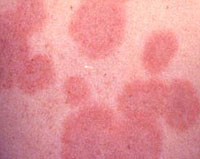 Initial lesions are usually erythematous macules or maculo-papules, which can be as small as 2 mm in diameter. Initial lesions are usually erythematous macules or maculo-papules, which can be as small as 2 mm in diameter.
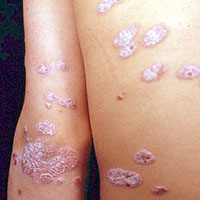 By peripheral extension large, scale covered patches appear. These lesions are sharply circumscribed and separated from the normal skin. The colour of the scales is described as silver-white, silver-gray or pearly. By peripheral extension large, scale covered patches appear. These lesions are sharply circumscribed and separated from the normal skin. The colour of the scales is described as silver-white, silver-gray or pearly.
If the scales are scratched away from the lesion, they fall of as tiny flakes (Candle sign). If the scale is removed totally, a moist, thin, translucent layer of skin is revealed. The lesion remains dry until this last level is reached (sign of the last Häutchen). If scratching is continued bleeding points appear (Auspitz sign). These bleeding points are thought to be the tips of the dermal papillae.
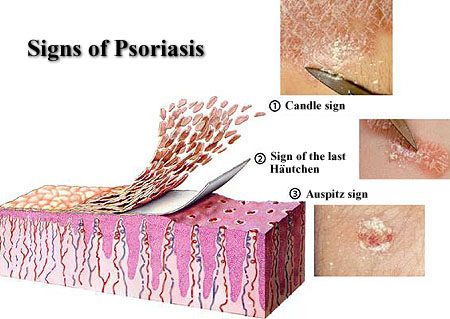
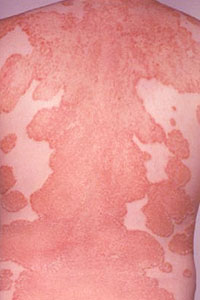 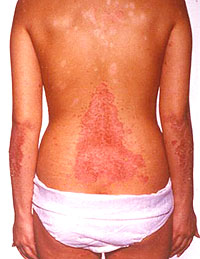 The early papular lesions start to expand and form different shapes. Some of the patches undergo involution in the center so curved patterns appear. These different types are named as serpiginous, annular, gyrate, guttate (like water drop) or rupial (like oyster shell). The early papular lesions start to expand and form different shapes. Some of the patches undergo involution in the center so curved patterns appear. These different types are named as serpiginous, annular, gyrate, guttate (like water drop) or rupial (like oyster shell).
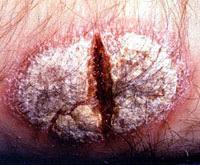 When the patches persist for a long time, the skin becomes thickened, develop fissures and thick scales cover the lesion, illustrative for old psoriasis lesions.
When the patches persist for a long time, the skin becomes thickened, develop fissures and thick scales cover the lesion, illustrative for old psoriasis lesions.
|

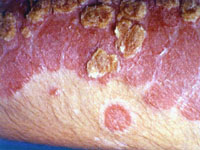
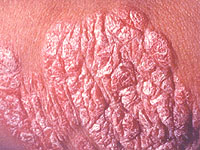
 Initial lesions are usually erythematous macules or maculo-papules, which can be as small as 2 mm in diameter.
Initial lesions are usually erythematous macules or maculo-papules, which can be as small as 2 mm in diameter.  By peripheral extension large, scale covered patches appear. These lesions are sharply circumscribed and separated from the normal skin. The colour of the scales is described as silver-white, silver-gray or pearly.
By peripheral extension large, scale covered patches appear. These lesions are sharply circumscribed and separated from the normal skin. The colour of the scales is described as silver-white, silver-gray or pearly.
 The early papular lesions start to expand and form different shapes. Some of the patches undergo involution in the center so curved patterns appear. These different types are named as serpiginous, annular, gyrate, guttate (like water drop) or rupial (like oyster shell).
The early papular lesions start to expand and form different shapes. Some of the patches undergo involution in the center so curved patterns appear. These different types are named as serpiginous, annular, gyrate, guttate (like water drop) or rupial (like oyster shell). When the patches persist for a long time, the skin becomes thickened, develop fissures and thick scales cover the lesion, illustrative for old psoriasis lesions.
When the patches persist for a long time, the skin becomes thickened, develop fissures and thick scales cover the lesion, illustrative for old psoriasis lesions.